What is MediaPass?
MediaPass gives online content owners -- from magazines and blogs to local newspapers – an easy way to have a sophisticated subscription model in a matter of minutes.
MediaPass for Joomla allows you to integrate MediaPass easily into your Joomla site, without the hassle of adding code in your HTML. You will be able to add MediaPass to all articles of selected categories automatically or to individual articles manually.
About Media Pass

Check the J.E.D, page on this extension and you will see it's brand new, added on September 30, 2011. There are no reviews or ratings as of this writing.
Media Pass is actually a subscription billing service, and the extension makes it easy to connect to the billing service and add payment collections to articles. Unlike other subscription services, this allows subscription to content for magazine, newspaper or learning content on an article by article, or category basis. You can mix free content with paid content on the same site.
The Media Pass extension gives you a quick and easy bridge to the service, that makes this all very simple to do.
Installation is simple. There are two versions for Joomla 1.5 and 1.7 that come in a single zip file. You'll need to download it and unzip it to get the right version for your installation. But once you unzip, the installation is fast and smooth using the Joomla Extension Manager.
Getting Started with videos
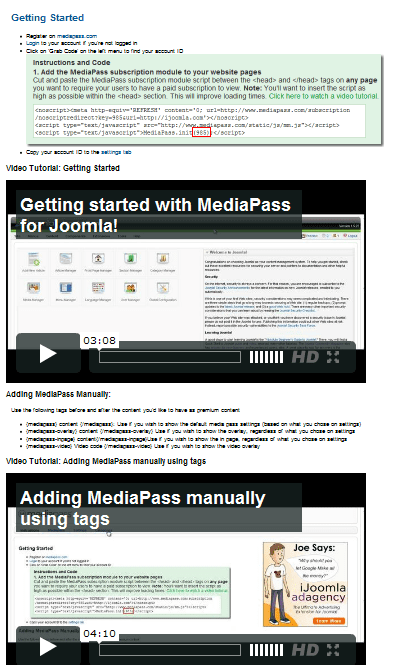
After installation everything you need to know to get started is right on the dashboard page. This was very impressive. Videos for setting up the program and for integrating it into your site are right there. Included are:
- Video Tutorial: Getting Started
- Video Tutorial: Adding MediaPass manually using tags
- Video Tutorial: Adding MediaPass automatically to all articles in a category
Tabs for set up functions.

The first thing I did was watch all three videos. Then I went through each of the tabs.
The videos are very straightforward and simple to follow, and stick to the essentials. This will let you make a quick setup and you can do the refinements later. I liked the fact that it was to the point, but the narrator made reference to "other videos" I could watch that would cover the details she was skimming over. It would be good if she referred to a specific video or told you where the video library was. But that is a very minor frustration.
Next I went to the MediaPass tab.
The MediaPass tab
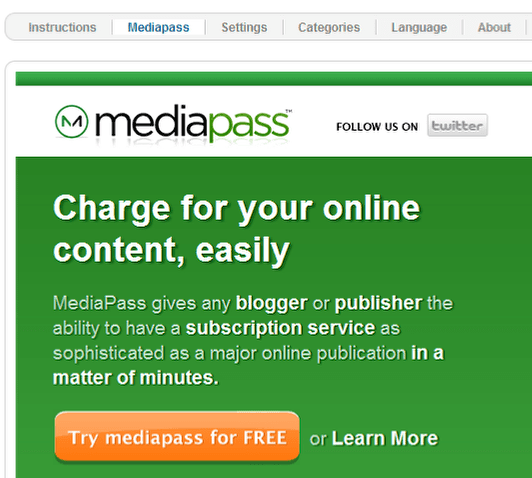
This is simply the Mediapass home page that opens in a frame. If you've already signed up you'll find a login button or you can click "Try MediaPass for FREE" and sign up now.
You will need to make an account for every site you use MediaPass on - even test sites.The other thing that is not obvious is the cost of Mediapass. It is a pay-as-you go service, so it's essentially free until a sale is made. But the percentage is 35% of the total sale. That may be worth it, but the price is buried in the MediaPass site under FAQ's and it takes a lot of searching to find it.
As far as the component is concerned I did not find any problems using it or making the connection.
Get your code and some more instructions
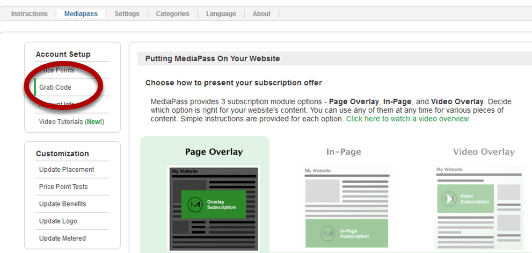
After logging into MediaPass, the first thing you need to do is get your code so you can complete the setup. The button is aptly labeled "Get Code" so there is no confusion here. On that page you get the code samples you need, plus a good explanation of the three integration methods.
- Page overlay - the form pops up in a lightbox
- In-Page - the form is embedded in the page
- Video Overlay - A video plays along with the form
Extracting the code

You need to scroll down and find the code to find your account number embedded in the code, which you will need for the setup. This seems like an unnecessary step. The number could be listed at the top of the page, and in your account information. The videos point the way to get this done, and it's not difficult, but if you haven't watched the video you're going to waste time looking for the account number.
Once you've recorded this code you are ready for the Settings tab.
Settings are simple
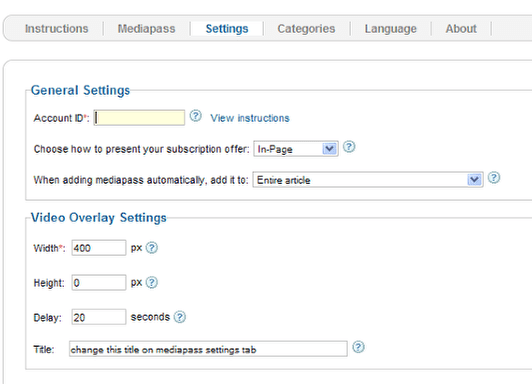
This is where you'll put the account ID you got from the last step. Also make some very easy to understand choices on how your presentation should look and act. You'll have your decisions made in a less than a minute. Then on to one of the best features. Assigning the module to categories.
Automatically assigning the sign up form to entire categories
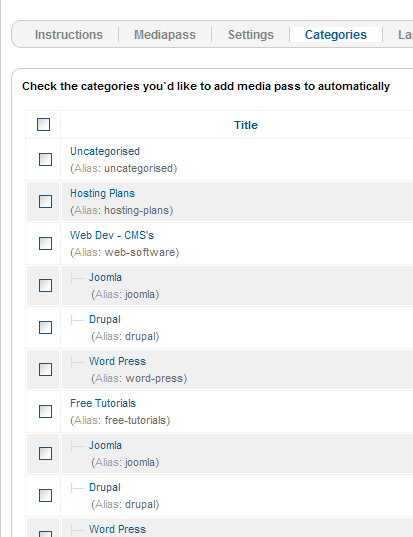
When you get to the categories tag you will see all of your Joomla categories. The only thing you need to do is click a check box, and you will have assigned the registration form to every article in the category and any of its sub categories. This makes it easy to divide your content up into sections that require a subscription and those that are free to the public.
Other methods for assigning MediaPass to content

You can also assign media pass to individual articles by using plugin tags similar to other plugin tags used in Joomla.
You can mix free and paid content on the same page. You can create a full page, but put the tags only around the content you want to charge for. This lets you write a teaser or sales message, and embed the sign up form where you would like to see it.
With this feature you can really fine tune the mix of free and paid content on your site. According to MediaPass, there is a mix that is optimal for the maximum return. With these tools you can easily experiment until you find the right mix. MediaPass also has tracking tools and testing tools as part of their service.
The MediaPass Service
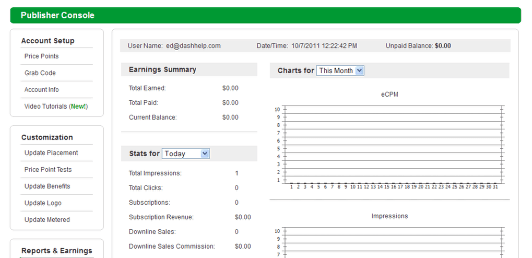
So far we've just looked at the plugin that allows you to connect to the service, and integrate with Joomla. The service itself proved to be just as easy to access and use. Except for the confusion over the domain name, the instructions and set up are easy.
Here's what's included in the service:
- pay all merchant processing fees
- handle all customer/subscriber support
- monthly billing,
- publisher support,
- customization,
- backend database management, development,
- PCI compliance
When you first login you will be greeted by an easy to understand Publishers console, with performance graphs, summary earnings and your menus for various functions.
In the Account Setup section, the most important section is the Price Points Section. This section was very confusing, and there wasn't any ready documentation on it. All of the other sections are what you would expect for a utility of this type, and are easy to understand and self-explanatory.
This section and the price of the service are really the most important features to discuss. After all, the burning questions are, "Can I use this and make a profit?"
Setting Price Points
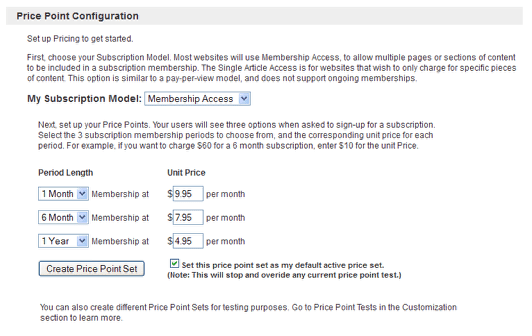
You set up price points with a simple enough form. You have two options for subscription mode - Membership Access and Single Article access. You can give your site visitors one price, and complete access to all paid material. Or you can put a price on each individual article. For example you could charge $5 per month for everything. Or $5 to view one article.
It doesn't look like you can mix the two subscription modes. It's going to be either one or the other for the entire site.
You fill in the price points, and click "Create Price Point Set", but it there is no indication that the set has been saved. The only one that appears in the price points is the default one. I kept testing this and kept trying to create price points, but got no indication that I had created any until I went to the Price Test section under the Customizations menu. There I found a long list of everything I tried to enter.
This could be improved by adding a field for a title for the set, and then displaying a table on the page below showing the name, the prices and an edit button
There does not appear to be a way to set different price points on different sections or articles. It's looks like it's all or none.
Testing Price Points
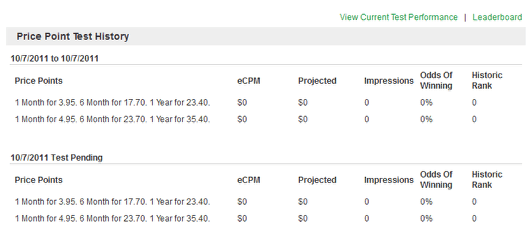
This is a great feature. Once you have several price points set up, you can have the service assign prices on a percentage schedule, The system will show one price X% of the time and the alternate price Y% of the time, and you can see which one gets the most conversions. This is a great way to fine tune your price points.
The drawback I can see is that now you'll have people subscribed at different prices, which could complicate renewals or create customer service problems. What do you tell the guy who subscribed this morning at $5, when his friend subscribed this afternoon for $2? There should be more help on how this is supposed to work.
The Good Parts
It's a big YES on usability, I would say that it is very smooth, well thought out, and operates exactly as promised. I think there are a few minor improvements to be made in the Price Points features, but this is a new extension and I wouldn't let this stop me from using it.
It's a also a yes on delivering as promised. It only took minutes to set up, all the documentation was right up front in easy to follow videos. I did not have to deal with credit cards, processing, complicated setups, applications, code or anything else. It's very efficient.
Being a brand new extension, I would imagine it can only get better.
The affiliate program could possibly be a good income stream. Although, there is very little information on how you get to a higher tier.
Could be better in some areas
For instance, it might be better if you didn't have to have a new account for every website. For example if you wanted to run a Joomla site with Joomla tutorials, but have a different site and URL for a WordPress site, you'd have to duplicate everything and keep two sets of data. Or suppose you run 10 or 20 local newspapers? Or publish two or three magazines?
It's not a serious drawback for the average user, but I can see large publication companies wanting that . Having been in the newspaper business I know that publishing companies often run more than one publication. Lack of scalability may make it less desirable.
The interface for setting and editing price points needs some work. It's a bit confusing and doesn't allow you to edit one once you've created it. There aren't any tutorials on this that I could see. Some more tutorials or instructions on pricing and testing would be a good addition.
The Cost
Can you make money? Personally I think 35% is a pretty big percentage. It might be worth 35% of start up investment if it was going to get better, but it would have to get a lot better.
If you need to pay for SEO or promotion or run pay-per-click advertising you're overhead expenses are going to start getting pretty steep. Not to mention what income tax is going to do to you. They hint that there are better prices for higher volume, but I would like to at least know the ballpark numbers. It would be good to see a price schedule that automatically kicks in discounts as you increase revenues.
As general business practice, it's not good to run any business that doesn't have a healthy profit margin. This appears to be a good product, but before you commit to it, see if your business model can support 35% off the top.
